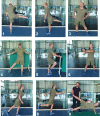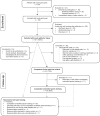Return to Sport After Criteria-Based Rehabilitation of Acute Adductor Injuries in Male Athletes: A Prospective Cohort Study
- PMID: 32064292
- PMCID: PMC6990618
- DOI: 10.1177/2325967119897247
Return to Sport After Criteria-Based Rehabilitation of Acute Adductor Injuries in Male Athletes: A Prospective Cohort Study
Abstract
Background: Despite being one of the most common sports injuries, there are no criteria-based rehabilitation programs published for acute adductor injuries.
Purpose: To evaluate return-to-sport (RTS) outcomes and reinjuries after criteria-based rehabilitation for athletes with acute adductor injuries.
Study design: Cohort study; Level of evidence, 2.
Methods: Male adult athletes with an acute adductor injury underwent a supervised, standardized criteria-based exercise rehabilitation program. Magnetic resonance imaging (MRI) was used to grade the injury extent from 0 (negative finding) to 3 (complete tear/avulsion). There were 3 milestones used to evaluate the RTS continuum: (1) clinically pain-free, (2) completion of controlled sports training, and (3) return to full team training. Subsequent injuries were registered within the first year.
Results: We included 81 athletes with an acute adductor injury (MRI grade 0: n = 14; grade 1: n = 20; grade 2: n = 30; grade 3: n = 17). Of these, 61 (75%) athletes achieved RTS milestone 1, 50 (62%) achieved RTS milestone 2, and 75 (93%) achieved RTS milestone 3. There were no statistical differences in the RTS duration between MRI grade 0, 1, and 2 at any RTS milestone; thus, these were grouped together as grade 0-2. The median time (interquartile range [IQR]) for athletes with grade 0-2 injuries to become clinically pain-free was 13 days (IQR, 11-21 days), to complete controlled sports training was 17 days (IQR, 15-27 days), and to return to full team training was 18 days (IQR, 14-27 days). For athletes with a grade 3 injury, median times were 55 days (IQR, 31-75 days), 68 days (IQR, 51-84 days), and 78 days (IQR, 68-98 days), respectively. The overall 1-year reinjury rate was 8%. Athletes who achieved RTS milestone 1 had a statistically significantly lower reinjury rate than athletes who did not (5% vs 21%, respectively; ϕ = -0.233; P = .048). Athletes who achieved RTS milestone 2 had a nonstatistically significantly lower reinjury rate than athletes who did not (6% vs 13%, respectively; ϕ = -0.107; P = .366).
Conclusion: We analyzed the results of a criteria-based rehabilitation protocol for athletes with acute adductor injuries. Athletes with an MRI grade 0-2 adductor injury were clinically pain-free after approximately 2 weeks and returned to full team training after approximately 3 weeks. Most athletes with an MRI grade 3 adductor injury were pain-free and returned to full team training within 3 months. Meeting the clinically pain-free criteria resulted in fewer reinjuries compared with not meeting the criteria.
Keywords: RTP; RTS; avulsion; groin; hip; muscle injury; muscle strain.
© The Author(s) 2020.
Conflict of interest statement
One or more of the authors has declared the following potential conflict of interest or source of funding: The publication fee for this article was funded by Aspetar Orthopaedic and Sports Medicine Hospital. AOSSM checks author disclosures against the Open Payments Database (OPD). AOSSM has not conducted an independent investigation on the OPD and disclaims any liability or responsibility relating thereto.
Figures




References
-
- Ardern CL, Glasgow P, Schneiders A, et al. 2016 consensus statement on return to sport from the First World Congress in Sports Physical Therapy, Bern. Br J Sports Med. 2016;50(14):853–864. - PubMed
-
- Bayer ML, Magnusson SP, Kjaer M; Tendon Research Group Bispebjerg. Early versus delayed rehabilitation after acute muscle injury. N Engl J Med. 2017;377(13):1300–1301. - PubMed
-
- Creighton DW, Shrier I, Shultz R, Meeuwisse WH, Matheson GO. Return-to-play in sport: a decision-based model. Clin J Sport Med. 2010;20(5):379–385. - PubMed
-
- Delmore RJ, Laudner KG, Torry MR. Adductor longus activation during common hip exercises. J Sport Rehabil. 2014;23(2):79–87. - PubMed
LinkOut - more resources
Full Text Sources

